The Structure of the Hydrogen Atom
Back to Main Hydrogen Atom Page

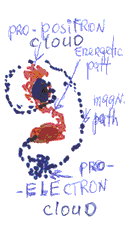
Wave theory introduces the idea of two swirls in one wave formation (see the introductory article) as the basic universal structure of every natural formation, including the hydrogen atom. On account of its high energetic capacity, the hydrogen atom is the most mercurial of all the atoms. It is a living, vibrating formation that is the basis of all living formations.
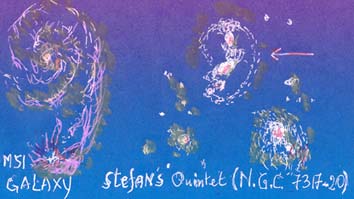
Notwithstanding the skepticism expressed by some scientists concerning
my ideas on galaxies, they are the most 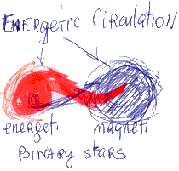 effective
example of wave structure. All I ask is that readers take a quick objective
look at galaxies as they actually exist (adjacent picture). Galaxies —
as is every single stable creation — are clearly composed of two
main loops (swirls) and behave in accordance with the guidelines that
I have postulated for energetic matter that is aligned within a wave formation
(one quant).
effective
example of wave structure. All I ask is that readers take a quick objective
look at galaxies as they actually exist (adjacent picture). Galaxies —
as is every single stable creation — are clearly composed of two
main loops (swirls) and behave in accordance with the guidelines that
I have postulated for energetic matter that is aligned within a wave formation
(one quant).
The galaxy in the picture above obviously consists of various formations. However, all the galaxy’s components are in close contact with all its other components and maintain their relative positions.

Energetic waves and its internal structures are well-defined, but have amorphous borders that enable energetic matter to communicate with its surroundings.

As Pauli contended in his exclusion principle, each single
component of energetic matter protects its own space, but
in my opinion the components always maintain contact with each other and
are in a constant state of superposition. Moreover, each unit of energetic
matter moves along its own path (Faymam’s remembers orbits) and
protects the integrity of its own defined borders. In other words, the
energetic wave is an independent form of energetic matter with distinct
boundaries. It resembles a living cell formation (adjacent picture) whereby
every signal is instantly transmitted throughout its area and elicits
a response all from the other elements within the wave.
The size of the “wave cell” is irrelevant. All wave formations — both as small as a cell and as large as the universe — react in an identical manner to energetic signals ( picture: below left). This ability allows the universe to exist and preserves its one quant structure, as any problems that arise are immediately repaired. The wave structure, then, is a network of energetic paths that are created by the circulating and spinning movement of energetic matter (picture: below, right).
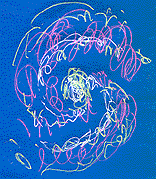
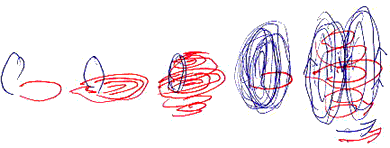
The energetic swirl — the core of the wave — constitutes one of the wave formation’s most vital components (pictures below).

It takes the form of a black hole in large galaxies, an energetic star in binary stars (the second star behaves like a neutron), and the proton in atoms. The latter can thus be considered the smallest example of a “black hole” known to man. In addition, every quark (string of raw energetic matter) creates closed formations (wave formations) in which the size of strings is insignificant. Each of these formations, including the proton, swallows energetic matter from its surroundings. Subsequently, the matter is processed into raw energetic matter and is expelled via singularity (picture: above, left).
These properties and behaviors have characterized every single energetic wave formation since the beginning of the universe. By dint of its swirling and spinning movement, energetic matter creates closed energetic wave formations that provide the location at which energetic matter can continue its perpetual movement. Smaller entities (quarks) instantly produce these formations, while huge formations require an extended period of time (as seen in one of the latest pictures of our universe that were taken by the Hubble Telescope) (picture: below, left). This resembles the sparks produced by welding metal (below, center), as wells as the quarks in the Wilson Chamber (below, right), which by their spinning and swirling movement form a symmetrical wave formation and subsequently disappear from our sight upon the formation of a photon



The energetic swirl (proton) sucks in energy through its opening. Its
swirling movement concentrates and then expels
the energy by way of singularity in packages of energetic matter that
are aligned in a rope-like loop formation (adjacent picture). The released
energy continues to swirl horizontally to the right as it did in the initial
formation — in a pattern of long horizontal and short perpendicular
paths (amplitudes). The energetic paths proceed onwards, and by means
of its particular movement create energetic concentrations that are called
positrons.
These concentrations contain all the characteristics of the proton, but
the proportion between the magnetic and energetic amplitudes changes as
does its swirling
and spinning movements. Moreover, they create a new loop (swirl) in which
the proportion of perpendicular spinning movement is greater than the
transversal swirling. This is referred to as a neutron formation.
The positron (the energetic cloud) formation appears at the end of the
energetic path (rope) because the neutron cannot absorb all the incoming
energy. Scientists have also named this positron cloud antimatter, because
of the supposed “annihilation phenomenon” that takes place
during its collision with electrons (picture below)

However, according to wave theory, there is no antimatter nor do these entities annihilate one another. They simply form wave formations that are similar to the photon. I predict that a spectrometer would identify this entity and designate it as the line of a new photon formation.
This engenders an accumulation of energetic matter (positron), which
necessitates the creation of the neutron formation. In hydrogen atoms,
there are a few small cloud-like
neutron formations that are spread out along its neutron (magnetic) paths.
The dimensions of the neutron formation correspond with the size of the
proton formation and are subject to the rate of incoming energy and the
ability of the neutron to store it.
Gradually, the neutron begins to expel excess energy that it constantly
receives from the positron. The energy forms an energetic path that spins
perpendicular to the proton-positron paths. In a neutron energetic formation,
the energy faces towards the inside and swirls perpendicular to the proton.
In the neutron’s (magnetic) swirl, the energetic matter faces inwards
and concentrates energy inside. This proves that the neutron is a highly-energetic
formation (hence the neutron bomb). The deuterium atom is a lucid example
of a neutron formation (pictures below).

In the hydrogen atom, this loop is formed by a few loose spirals. The
neutrons are assembled in nebulous clouds that are so energetic that their
gravitational pull hovers around zero or is even negative. Therefore,
its neutron’s gravitational properties are negative, which explains
why scientists have difficulties comprehending the structure of the hydrogen
atom. Furthermore, its perpendicular loops are less concentrated and disperse
along its highly energetic magnetic path. Consequently, the neutron’s
loops in the hydrogen atom are dispersed and highly energetic —
like the photon — and thus possess less gravitational force. Moreover,
concentrations of energetic matter — referred to as electrons —
are found on the tips of its perpendicularly swirling loops (as in the
positron). Due to the sucking properties of the proton, the tip of the
magnetic path, the location of the electron is located, is always in the
vicinity of the proton’s opening. A closed circle of energetic movement
that resembles a cirulus viciosum is thus formed near the opening, where
energy congregates before entry. The exact manner in which energetic matter
circulates within the positron and electron, and which subsequently forms
another swirl, is most peculiar and is thus very difficult to comprehend.
There cannot be a more ingenious creation!! This virtual formation appears to be tenuous, especially on account of its obscure borders; however, it is actually a solid formation with a defined area, and it reacts to internal and external signals immediately.
A black hole that attracts a considerable amount of energetic matter
can create more than one “storage” swirl. This also occurs
in concentrated energetic atoms. For
example, hydrogen atoms in frigid water lose energy and are less active,
and its energetic matter is more concentrated. Therefore, they create
more compact neutron loops, deuteriums, and tritiums. These particular
deuteriums atoms are toxic to living formations, as they are incapable
of providing energy to “living tissues” (like the original,
highly-energetic hydrogen atom).
Highly-energetic hydrogen atoms prevent neutron formations from developing
stable storage “tanks” in which  to
conserve energetic matter. Instead, as mentioned above, it apparently
produces a row of small tanks that expel excess energy via the neutron’s
rope, in which energy circulates perpendicular to the proton and positron.
to
conserve energetic matter. Instead, as mentioned above, it apparently
produces a row of small tanks that expel excess energy via the neutron’s
rope, in which energy circulates perpendicular to the proton and positron.
However, the energetic properties face towards the inside of these formations (in contrast to the positron’s properties that face towards the outside). The hydrogen atom, like the photon, is highly energetic, and is capable of transferring an extensive amount of energy, but cannot store much energy. In a molecular formation with other atoms, hydrogen atoms create highly energetic, “living” swirls (picture below). (This process is examined comprehensively in the article on life formations.)
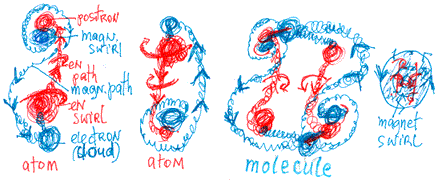
In fact, hydrogen is even more vital to living formations than oxygen: in volcanic areas deep beneath the ocean surface, many organisms survive without any access to oxygen. The presence of high-energy hydrogen in these locations reinforces the significance of water (H2O) for living formations.
The hydrogen atom is thus the classic example of a wave formation. Not only does the two-swirl wave formation (a quant) constitute the basic formation of the hydrogen atom, but also serves as the master plan for everything in the universe! This simple elegant formation is the fundamental blueprint of nature. It is marvelous and beautiful, but it is so sophisticated that it will probably take generations to fully comprehend.
These simple wave and cloud-like cell formations possess infinite amounts of properties. The hydrogen atom appears to maintain its wave formation, but it nevertheless has the characteristics of an entity that is somewhere between a photon and a stable wave-particle formation. Research on the properties of the hydrogen atom’s and the photon, which are still at a nascent stage, may lead to advances in gene transfer.
Today, the scientific community is preoccupied with conducting experimental studies. As beautiful and sophisticated as these experiments may be, they do not provide comprehensive or precise explanation for actual events and phenomenon. A general, all-encompassing theory is thus needed to coordinate and synergize the copious amount of information that is produced. Wave theory is only the first step towards a grand unified outlook, and many of my ideas will inevitably undergo major revisions. Nevertheless, the two-swirl structure of energetic matter (quants) and its attendant behaviors will form the very basis of future scientific enterprise.
- end -
Dr. Chaim Tejman, Copyright© 2003. All rights reserved.